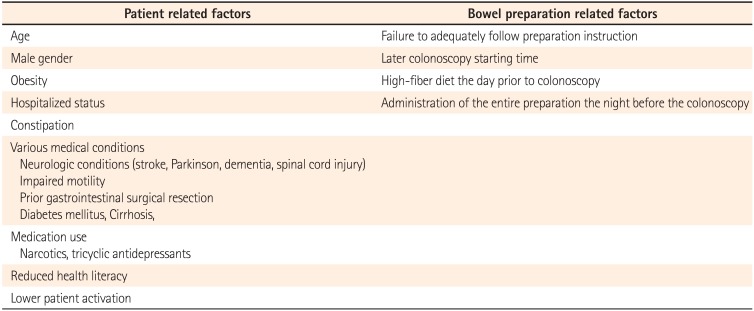I read with interest the paper by So et al., "Patient descriptions of rectal effluents may help to predict the quality of bowel preparation with photographic examples",1 which showed that photographic example-guided patient descriptions of rectal effluents may predict the quality of bowel preparation.
This article represents an important issue on the quality of bowel preparation. Approximately 25% of colonoscopies performed are considered to have inadequate preparation,23 which results in many adverse consequences including a lower detection rate of adenoma, prolonged cecal intubation time, prolonged withdrawal time, increased costs of colorectal cancer prevention, and increased patient dropout rates from colorectal cancer screening programs.4
Several patient-related and precolonoscopic bowel preparation-related factors are demonstrated to be linked to inadequate bowel preparation (Table 1).45 The 2015 guidelines from the American Society of Gastrointestinal Endoscopy recommended that patients who have a medical predicator for inadequate preparation or a history of inadequate preparation should be considered to be prescribed more aggressive preparation.5
Patients with inadequate preparation usually require a repeat examination with more aggressive colonic cleansing, a repetitive endoscope disinfection, and intravenous sedation. These repeated procedures are time- and cost-consuming. Therefore, if patients' descriptions of rectal effluents can predict the quality of bowel preparation before colonoscopic examination, this would be a very useful time-saving and cost-saving method. In the case of a prediction of inadequate preparation, these patients may benefit from additional preparation, which may be particularly useful if it can be administered in the endoscopy unit followed by colonoscopy on the same day. Fatima et al.6 reported only a slight agreement between the patients' descriptions of rectal effluent and the bowel preparation quality, but patients reporting rectal effluent as brown liquid or solid have a substantial likelihood of inadequate preparation.
So et al. developed a new scoring method that could describe rectal effluent more objectively and accurately, and evaluated its efficacy in predicting the quality of bowel preparation. They showed that photographic example-guided patient descriptions of rectal effluents showed a statistically significant association with the quality of bowel preparation. I believe this method may be slightly too complex and difficult to apply to the general population. The high drop-out rate (68.1%) in this study may be related to this. (In the text, the reasons for exclusion were not described fully.) Identifying the exact grade of the last three rectal effluents by photographic examples may be difficult, especially in patients with patient-related risk factors for inadequate bowel preparation. Matching only the last rectal effluent with photographic examples could have higher accuracy and applicability. In addition, among the photographic examples, the differences between B and C and the description of D (liquid with small amount of feces) are ambiguous. The development of a more easily applicable classification of rectal effluent using photographic examples is needed.
I think that the specificity is more important than the sensitivity in a predictive factor for suboptimal preparation. If the cutoff value is determined as 4, most subjects would get additional bowel preparation, which is not cost-effective.
Interestingly, they found that the presence of diverticula was an independent predictive factor for suboptimal quality. A further, large scale study to identify the associations between diverticulosis and bowel preparation quality will be warranted. Old age, obesity, and physical inactivity are known to be risk factors for both colonic diverticulosis and inadequate bowel preparation. The consideration of these confounding factors will be very important in these studies. In addition, the location and number of diverticula may be important and an interesting factor, as authors mentioned.
In conclusion, So et al. provide a new surrogate indicator in predicting the quality of bowel preparation, but modification is needed in order to correctly predict the status of bowel preparation and to make it more easily applicable.
References
1. So H, Boo SJ, Seo H, et al. Patient descriptions of rectal effluents may help to predict the quality of bowel preparation with photographic examples. Intest Res. 2015; 13:153–159. PMID: 25932000.

2. Harewood GC, Sharma VK, de Garmo P. Impact of colonoscopy preparation quality on detection of suspected colonic neoplasia. Gastrointest Endosc. 2003; 58:76–79. PMID: 12838225.

3. Froehlich F, Wietlisbach V, Gonvers JJ, Burnand B, Vader JP. Impact of colonic cleansing on quality and diagnostic yield of colonoscopy: the European Panel of Appropriateness of Gastrointestinal Endoscopy European multicenter study. Gastrointest Endosc. 2005; 61:378–384. PMID: 15758907.

4. Cohen LB. Advances in bowel preparation for colonoscopy. Gastrointest Endosc Clin N Am. 2015; 25:183–197. PMID: 25839681.

5. ASGE Standards of Practice Committee. Saltzman JR, Cash BD, et al. Bowel preparation before colonoscopy. Gastrointest Endosc. 2015; 81:781–794. PMID: 25595062.

6. Fatima H, Johnson CS, Rex DK. Patients' description of rectal effluent and quality of bowel preparation at colonoscopy. Gastrointest Endosc. 2010; 71:1244–1252. PMID: 20362286.

Table 1
Risk Factors for Inadequate Bowel Preparation





 PDF
PDF ePub
ePub Citation
Citation Print
Print


 XML Download
XML Download